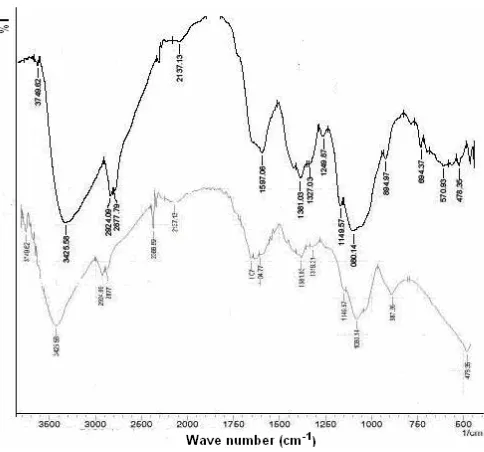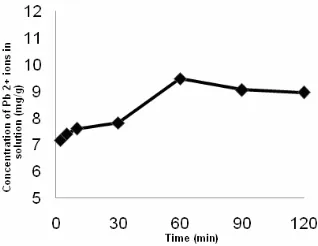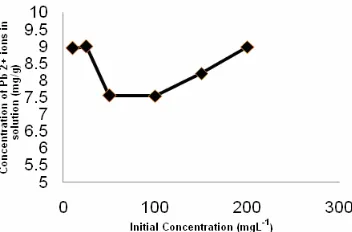IMMOBILIZATION OF
Saccharomycess cereviceae
BIOMASS ON CHITOSAN
AND ITS APPLICATION AS AN ADSORBENT FOR Pb(II) ION
Hasri
1,2,*, Mudasir
3, Nurul Hidayat Aprilita
3, and Roto
3 1Postgraduate Student of Chemistry Department, Faculty of Mathematics and Natural Sciences, Universitas Gadjah Mada, Sekip Utara, Yogyakarta, Indonesia, 55281
2
Department of Chemistry, Faculty of Mathematics and Natural Sciences, Makassar State University, Parangtambung, Makassar, Indonesia
3
Department of Chemistry, Faculty of Mathematics and Natural Sciences, Universitas Gadjah Mada, Sekip Utara, Yogyakarta, Indonesia, 55281
Received February 10, 2011; Accepted July 15, 2011
ABSTRACT
An application ofSaccharomycess cereviceae biomassimmobilized on chitosan (SC-Chi adsorbent)for Pb(II) ion removal was demonstrated. Adsorption experiment was conducted at various mass ratio of Saccharomycess cereviceae biomass to chitosan, contact time, pH of solution and concentration of cation. Total Pb(II) metal ion adsorbed was calculated from the difference of the amount of metal ion before and after adsorption which was measured by AAS. The results showed that optimum condition for adsorption of Pb(II) ion by the SC-Chi was achieved using mass ratio of Saccharomycess cereviceae to chitosan of 50% (w/w), pH solution of 7, contact time of 60 min and concentration of 25 mgL-1. The hydroxyl (-OH) and amino (-NH2) functional groups are believed to be
responsible for the adsorption of Pb(II) ion by the adsorbent.
Keywords:Immobilization, Saccharomycess cereviceae biomass, chitosan, adsorption, Pb(II) ion
INTRODUCTION
Various methods have been developed to remove heavy metals in the contaminated environment. In general, it can be done through ion exchange or precipitation in the form of insoluble solids. However, this method is costly because it requires materials to re-adsorb inorganic compounds [1].
The work was conducted to minimize the concentrations of heavy metal cations from liquid waste and sediment, focusing at the development of new materials that have high affinity, selectivity and ability to adsorb the cations [2]. One of promising methods is by utilizing microorganism as biosorbent. This may support attempts to environmental protection via reduce and reuse technology.
Microorganisms either dead or alive have ability to accumulate metal ions especially because of cell wall composed of polysaccharide, lipid and protein that consist of carboxylic, hydroxyl, sulfohydrile, phosphate and amino groups can form chelate with metal ions [3-6]. A wide range of polymers has been tested in the attempt to develop supports for cell immobilization [7]. Chitosan, a copolymer of b-1,4-linked D-glucosamine and N-acetyl-D-glucosamine residues derivated by the deacetylation of chitin, presents several advantages over other polymers. The amino groups of the polymer, under acidic conditions, can interact with polyanionic
counterions to form gels which can be appropriately managed for cell entrapment. Besides, the use of chitosan as matrix for cells immobilization might contribute to recycle the chitin waste originated from shrimp farming and it could become a profitable income source especially in regions where aquaculture is prevalent. Chitosan was selected as support matrices for immobilization process since chitosan has functional groups such as -OH, -NH2 and -NHCO-groups that can form chelate with some metal cations. In addition, chitosan is abundant in nature, for example in crab and shrimp shell and more importantly non toxic.
The Saccharomycess cereviceae was applied as
adsorbent because it has very high surface area that is suitable for absorption of selected cations [8]. Further, adsorbent derived from Saccharomycess cereviceae
EXPERIMENTAL SECTION
Materials
Shrimp shell waste (Penaeus monodon) was obtained from P.T. Kima, Makassar. Pure culture of
Saccharomycess cereviceae strain FNCC 3012 was a
collection of Microbiology Laboratory, Inter-University Center (PAU), Universitas Gadjah Mada, Yogyakarta. Reagents are all in analytical grade comprising of Pb(NO3)2, HCl, NaOH, CH3COOH supplied by Merck. Distilled water and doubly distilled water were purchased from the Chemistry Laboratories, UGM.
Instrumentation
Instrumentations used in this experiment are IR spectrometer (Shimadzu Prestige-21), Atomic absorption spectrophotometer (Perkin Elmer 3110), X-ray diffraction (Shimadzu XRD-6000) and scanning electron microscope (SEM).
Procedure
Preparation of metal stock solution
Pb(II) metal solutions were prepared by diluting a stock solution of 1000 mgL-1 of Pb(NO3)2 with doubly distilled water to make concentrations ranging from 10 to 200 mgL-1. For each solution, the initial Pb(II) concentration and the concentration in the mixture after adsorption experiment were determined using an Atomic Absorption Spectrometer (Perkin ElmerModel 3110).
Microorganism production medium
Pure culture of Saccharomycess cereviceae
(Culture Collection of the Microbiology Laboratory UGM) was used in this experiment. It was maintained on potato glucose agar slants at 30 °C. To produce biomass powder, a 100 mL of potato glucose medium was inoculated in the 250 mL conical flasks with spore suspension and grown in submerged culture conditions. Biomass of fungi mycelium harvested by filtration from the growth medium and washed several time using doubly distilled water. The obtained fungal biomass was dried at 60 °C. Prior to further processing, the powders were ground and sieved into particle size range of less than 100 mesh.
Immobilization of Saccharomycess cereviceae Chitosan was prepared from shrimp shell waste through deproteination followed by demineralization and deasetilation processes according to the method reported earlier [7].
To prepare highly swelling beads, an amount of chitosan powder mixture ofSaccharomycess cereviceae
(100 mg) was completely dissolved in 20 mL 2% (v/v) acetic acid. Saccharomycess cereviceae beads were prepared by adding NaOH solution drop-by-drop. The beads were stirred slowly for 30 min, washed with distilled water until the solution became neutral. The resulting adsorbent was dried and stored before use.
Adsorption studies
The adsorption of Pb(II) ion by Saccharomycess
cereviceae immobilized chitosan (SC-Chi) from
aqueous solution was investigated in batch systems. The mass ratio of Saccharomycess cereviceae
biomass to chitosan was optimized. The effects of the pH, contact time, the initial concentration of Pb(II) ion, and adsorption capacity were also studied.
Mass ratio of Saccharomycess cereviceae biomass to chitosan
The studies consist of determination of optimum mass ratio of Saccharomycess cereviceae biomass to chitosan (10 to 50% by weight), using a batch volume of 10 mL containing Pb(II) ions of 100 mgL-1, 100 mg adsorbent. The mixture was stirred for 60 min. The adsorbed Pb(II) ions were calculated from the difference of the initial concentration Pb(II) ion and after the adsorption. Pb(II) ions were determined by AAS. The experiment was done at initial pH of 7. All experiments were performed in triplicate trials. After adsorption completed, the adsorbent was characterized using an FTIR (Shimadzu Prestige-21), a scanning electron microscopy (SEM), and X-ray diffraction (Shimadzu XRD-6000).
Effect of pH
The adsorption rate of Saccharomycess cereviceae immobilized chitosan (SC-Chi) was tested at the pH range from 2 to 9, batch volume of 10 mL, Pb(II) concentration of 100 mgL-1, and mass of adsorbent of 100 mg. The pH of the solution was adjusted using 0.1 M HCl or 0.1 M NaOH. After the mixture was stirred for 60 min, the supernatant was analyzed for Pb(II) content. The Pb(II) ion adsorbed were determined by subtracting the concentration of Pb(II) in the initial with the final solution. The samples were analyzed using an atomic absorption spectrophotometer (AAS).
Effect of time contact
An amount of 100 mg of Saccharomycess
cereviceae immobilized (SC-Chi) powder was used.
the solution, filtered, and analyzed. Adsorbed Pb(II) ion were determined from the difference of Pb(II) in the initial and final solution. The Pb(II) ion concentrations in the sample solutions were analyzed using AAS.
Effect of initial Pb(II) ion concentration
The Pb(II) ion solutions with concentration of 20, 50, 100, 150 and 200 mgL-1 were stirred with solution volume of 10 mL, at certain pH and contact time. Adsorbed Pb(II) ion were determined from the difference of Pb(II) in the initial and final solution. The Pb(II) ions concentrations in the sample solutions were analyzed using AAS.
Data analysis
The content of metal ion adsorbed by the adsorbent is plotted using the following expression:
q= (Co-Ce)V/m (1)
q is the amount of metal ion adsorbed onto the unit amount of the adsorbent (mgg-1). Co and Ce are the initial and equilibrium concentration of Pb(II) ion (mgL-1) after adsorption, respectively. V is the volume of the adsorption medium and m is the amount of the adsorbent (g).
The empirical Langmuir equation which is valid for monolayer adsorption onto a completely homogeneous surface is given by eq. 2:
qe=qmaxKCe/(1+KCe) (2)
where qe is the equilibrium metal ion concentration on the adsorbent (mgg-1), Ce is the equilibrium metal ion concentration in the solution (mgL-1), q max is the maximum monolayer adsorption capacity of the adsorbent (mgg-1), and K is the Langmuir adsorption constant (lmg-1) related with the free energy of adsorption[8,16].
The Freundlich model assumes a heterogeneous adsorption surface and active sites with different energy. The equation representing Freundlich model is:
qe= KfCe n
(3) where Kf is a constant relating the adsorption capacity and n is an empirical parameter relating the adsorption intensity with the heterogeneity of the material [9].
RESULT AND DISCUSSION
Ratio of Saccharomycess cereviceae biomass on chitosan
The adsorbent made by immobilizing
Saccharomycess cereviceae on chitosan (SC-Chi
adsorbent) with mass ratio of 50% (w/w) is reasonably good to be used to remove Pb(II) ion.
Fig. 1 shows the FTIR spectra of the adsorbent (SC-Chi). Significant changes in the absorption spectra
Fig 1.Infrared spectra of Saccharomycess cereviceae (SC),chitosan(Chi) and SC-Chi
Fig 2. FTIR spectra of the SC-Chi adsorbent before (bottom) and after (top) interaction with Pb(II) ions
Fig 3. X-Ray diffractogram of Saccharomycess cereviceae (SC), chitosan (Chi) and SC-Chi
Fig 4. SEM images of chitosan (magnification 3500x, top) and SC-Chi (magnification 1750x, bottom)
Fig 5. Effect of pH on adsorption of Pb(II) ions by SC-Chi sorbent, Pb(II) 100 mgL-1; in which sample volume was 10 mL and contact time was 60 min
Fig 6.Effect of contact time on adsorption of Pb(II) ions on by SC-Chi, in which Pb(II) was 100 mgL-1 and sample volume was 10 mL
vibration of C=O of peptide and of N-H. This data suggest that the interaction between Saccharomycess cereviceae and chitosan has occurred. The functional groups were amino (-NH2), hydroxyl (-OH), carboxyl (-COO), carbonyl (-C=O) mainly responsible in
Saccharomycess cereviceae (SC), chitosan (Chi) and
immobilizedSaccharomycess cereviceae(SC-Chi).
Effect of pH
The effect of pH on Pb(II) adsorption onto SC-Chi adsorbent was studied at various pH (from 2 to 9). The adsorption process involves amine and carboxylic functional groups. These groups are affected by solution pH. Therefore, the amount of Pb(II) adsorbed will be greatly influenced by H+(or OH-) concentration. Data are shown in Fig. 5.
The adsorption of Pb(II) ion by the SC-Chi adsorbent increases as pH increased and reaches the maximum at pH 7. At low pH, the amine is in protonated
form, preventing Pb(II) ion to make complex. At much higher pH, Pb(II) can be precipitated out [6].
Effect of contact time
The effect of contact time on the adsorption of Pb(II) ion is depicted in Fig. 6. The adsorption rate was fast in the first 60 min and was getting slow afterwards. The adsorption reaches equilibrium after 60 min. However, it decreases at much longer time scale.
It is typical the fast adsorption rate at its initial stage was due to availability of the binding sites. The rate of reaction decreases at longer time and finally reaches equilibrium.
Effect of initial Pb(II) ion concentration
Fig 7. Effect of initial concentration on adsorption of Pb(II) ion by SC-Chi adsorbent, with sample volume of 10 mL and contact time of 60 min
Fig 8.Langmuir isotherm plot for Pb(II) ion adsorption by SC-Chi adsorbent
Table 1. Isotherm parameters for Pb(II) adsorption on SC-Chi
The adsorption of Pb(II) ion increases as the initial concentration increases and reaches maximum at 25 mgL-1. At low concentration, there would be more active sites than the available Pb(II) in the solution. At concentrations higher than 25 mgL-1, the surface of the adsorbent becomes saturated therefore no more ions will be adsorbed (Fig. 7).
Fig. 8 shows Langmuir isotherm plot for Pb(II) ion adsorption by SC-Chi adsorbent. From the plot, it can be extracted to obtain qm = 8 mgg
-1
, b = 0.141, and correlation coefficient (r) = 0.998. This suggests that adsorption of Pb(II) ion by SC-Chi adsorbent fits Langmuir equation, confirming that the adsorption follows a single molecular monolayer adsorption mode. For single layer adsorption mode, the amount of adsorbent is so critical to obtain a Langmuir fit.
The Pb(II) adsorption capacity of the adsorbent was evaluated using Langmuir and Freundlich adsorption isotherm. The adsorption isotherm is fundamental in describing the interaction behavior
between the ions and adsorbent. The isotherm plot yields constant values that correspond to the surface properties and affinity of the adsorbent. It also plays an important role to understand the adsorption model.
Table 1 presents the isotherm parameters for both Langmuir and Freundlich isotherm fits. From linear parts of correlation coefficients of the adsorption isotherm, the Langmuir isotherm model shows better fit to the adsorption data than that of Freundlich isotherm model. Again, this phenomenon suggests that adsorption of Pb(II) ion by the adsorbent is indeed to follows monolayer adsorption.
CONCLUSION
Saccharomycess cereviceae immobilized on
chitosan (SC-Chi) is potential for heavy metal ions removal since it is easy to prepare, eco-friendly, and has good adsorption capacity. It is of agricultural and fishing industry wastes. It shows that optimum condition for adsorption of Pb(II) ion by this adsorbent is obtained with weight ratio of biomass to chitosan of 50%, pH of solution of 7, contact time of 60 min and initial Pb(II) concentration of 25 mgL-1. The hydroxyl (-OH) and amino (-NH) functional groups are believed to be responsible for adsorption of the cations. This type of adsorbent is stable and could possibly be used for adsorption of other toxic metals in waste water systems.
ACKNOWLEDGEMENT
The authors would like to thanks the Directorate of Research and Community Services, Directorate General of Higher Education (DP2M-DIKTI No:015/023-04.2/XXIII/2010), National Education Department of Indonesia for financial support to this work.
REFERENCES
1. Khoo, K.M.; and Ting, Y.P., 2001, Biochem. Eng. J., 8, 51–59
2. Volesky, B., and Holan, Z.R., 1995,Biotechnol.,11, 234–250
3. Gadd, G.M., 1990a,Chem. Ind., 13, 421–426. 4. Gadd, G.M., and White, C., 1993, Trends
Biotechnol.,11, 8, 353–359.
5. Tobin, J.M., White, C., and Gadd, G.M., 1994, J. Ind. Microb.Biotechnol., 13, 2, 126–130.
6. Veglio, F., Beolchini, F., and Toro, I., 1998, Ind. Eng. Chem. Res.,37, 1107–1111.
8. Hong, N.K., Meyer, S.P., and Lee, K.S., 1989, J. Agric. Food Chem.,37, 575.
9. Tsezos, M., and Volesky, B., 1981, Biotechnol. Bioeng., 23, 583–604.
10. Kurita, K., Sannan, T., and Iwakura, Y., 1998, J. Appl. Poly. Sci., 23, 511–515.


